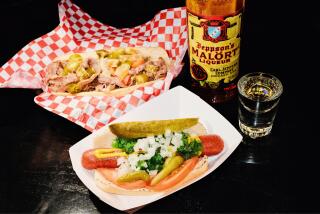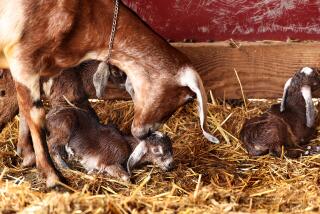The Little Cheese Man
- Share via
VISALIA — Bill Boersma’s father was a dairyman, and his grandfather before him. In California, that’s a perfect pedigree for going into real estate. Precious few family farmers have managed to cling to a dying trade. Boersma has done it by turning to cheese-making.
He is pinning his hopes on Cheddar, one of the most difficult cheeses to master. Doing this on a farm using unpasteurized milk from his own herd is his last bid to survive in an industry that has all but forsaken tradition for intensification--stocking more animals on less space.
The numbers, Boersma says, tell the story. “When I was born in 1951, California had 11 million people and 25,000 dairymen. Today it has 33 million people and 2,300 dairymen.” The average herd size then was 42 cows. Today it is upward of 600.
California’s cataclysmic growth has kept Boersma on the move. When he was born to Dutch immigrants near Artesia, it was countryside. “My birth certificate says ‘rural Artesia,’ ” he jokes, “as if there was an urban one.”
Rural Artesia imprinted his notion of paradise. “When I was growing up, we always pastured dry stock: cows that weren’t milking or heifers,” he says. “It was one of my duties to cut down weeds, and I learned to love pastures. I just loved being out there and looking at wildlife and cows as they’d walk by.”
In 1967, as developers began buying up L.A.’s dairy farms, his family moved to Chino. By 1972, Boersma had taken over his father’s farm and was keeping 250 cows. But by the late 1970s, he was again on the move, this time fetching up in the Central Valley. Here, in 1979, against the backdrop of the Sierra, he found his new home: 100 acres in Tulare County in the grid-work fields of Visalia.
Sensitive to the difficulty that pronouncing his Dutch surname poses for Americans, he called his new place Bravo Farm. He started with 250 cows. However, to stay profitable, he had to increase his herd size. The stock steadily escalated, first to 300 cows, then 350, 400 and finally 450.
He had, he realized, gone from being a dairyman to being a factory farmer. With 450 head, he was keeping at least 250 more cows than he could allow to graze free. His cows would never know spring pasture and their milk would never carry flavors of meadow grass. They would be fed year-round on commercial formulas, including nut husks, alfalfa and bruised citrus.
As an experiment, he put 90 milking cows on grass.
“For the first week, the cows nearly starved,” he says. “They walked on the feed for a week and a half before they realized it was feed that they were stomping on. It was the first time in my life that I backed up and said, ‘My God, what have we done? We’ve nearly bred the grazing out of these animals.’ It was really an emotional thing.”
Cows that don’t graze are now the norm in California, the leading milk producer in the United States.
“I hesitate to put our industry down, because it’s a good industry,” he says. “But if there were a way for cows to speak to us, they would probably tell us where to put our ‘cow comfort.’ ”
Boersma’s crisis of conscience came in August 1990, when the milk market collapsed and his family’s income dropped by one quarter. “We decided that we had to grow very, very large or go into something else,” says Boersma.
Unlike other farmers scrambling to survive, the Boersmas decided that enlarging their herd again was not an option. Nor was use of the 1993 wonder drug, the hormone Posilac, a brand name for bovine somatotropin, or BST.
“I absolutely refused to use it,” Boersma says. “When it first came out, I had about 21 questions. And the only answer I ever got was, ‘No problem.’ I have used hormones before to synchronize my breeding. It wasn’t 100% ‘no problem.’ ”
Instead, in 1995, the Boersmas decided to turn to cheese-making. “At first we thought we would just do the Cheddar so we could practice,” he says. “We were actually in production before I realized that I needed a milk handler’s permit. Then when I applied for that, I found nobody else was doing it.”
Initially, Boersma got little support from the state licensing authorities. “They didn’t know what to do with me,” he says. “The first thing that they wanted me to do was to get a bond. Every cheese processor has to be bonded in the state of California. It guarantees that they will pay for the milk that they purchase. Since we have our own milk, I had to explain to them that any losses would be my own.”
But even using his own milk, getting the flavor and texture he wants will take time.
He is sticking with the early decision to use raw rather than pasteurized milk. “It’s legal as long as you age it 60 days, assuring that the pathogens that might have been there are killed off,” he says. “I just decided that raw milk flavor was what I wanted.”
This he got. But in 1998, Boersma wanted more time to work on his cheese, so he sold 350 Holsteins, keeping only 100 of his favorite Brown Swiss cows.
His dream was making a Cheddar on par with the English original, but he was selling, he realized, to an audience more likely to equate Cheddar with Velveeta.
“Confusion about the nature of real Cheddar has been our biggest nemesis,” Boersma says.
One key trait of real English Cheddar--the complex array of flavors from flowery to peppery that comes from grazing on good pasture--will have to wait. Boersma cannot begin experiments developing pasture capable of withstanding California heat until a tenant farmer leaves his land next year.
In the meantime, his challenge is reaching the real Cheddar market while not losing the factory cheese fans. “You have to find a balance between the purists and reality,” he says.
He won the approval of purists by forsaking the orange vegetable dye used by processed Cheddar makers and styling his cheese “white Cheddar.” But when it came to maturing the cheese, Boersma made a commercial choice: to age it in plastic-wrapped blocks.
Traditional English Cheddar is aged in cloth-bound wheels, which allow the moisture to evaporate as the cheese matures. As this happens, the flavor sharpens, a process summed up in the slogan on Boersma’s sweatshirt: “Age is not important unless you’re a cheese.”
Boersma knows that his use of plastic blurs the distinction. He is experimenting with cloth and making cheese in large rounds, he says, but for now the plastic-wrapped blocks are easier to handle and sell.
The upshot is that Boersma’s cheese is distinctly superior to factory Cheddars sold in supermarkets, but still short of the classic wheels from England and the Northeastern United States. But Boersma has pitched the price accordingly. English farmhouse Cheddar costs $15 a pound, a New York Cheddar, $11; Boersma’s is more like $6.
He also produces jalapeno- and chipotle-spiced Cheddars. When challenged about the use of special flavorings, a measure scorned by cheese purists, he is unembarrassed. And he is almost instantly vindicated when a local farmer shows up asking specifically for the jalapeno cheese. “See?” he says, pointing to his customer, “People like it.”
So far, Boersma says, the small-is-beautiful gambit is working. He has raised his standards but remained within reach of the common purse. But he says he has much still to learn, to do. Once he masters the cheese, he must restructure his farming methods.
Ironically, his turn away from the methods of the power dairies defended by the industry is now being endorsed by it.
He is, the California Milk Advisory Board declares, one of a handful of cheese makers leading “a renaissance in artisan cheese-making that begs comparison with the state’s dynamic growth in fine winemaking in the 1970s.”
*
Bravo Farms cheeses are available by mail order or through the Internet. Medium Cheddar, $5.98 per pound plus postage; sharp, $7.98 per pound; jalapeno and chipotle, $6.98 per pound. (559) 625-0490; fax: (559) 625-0490; e-mail: [email protected].
More to Read
Sign up for Essential California
The most important California stories and recommendations in your inbox every morning.
You may occasionally receive promotional content from the Los Angeles Times.









